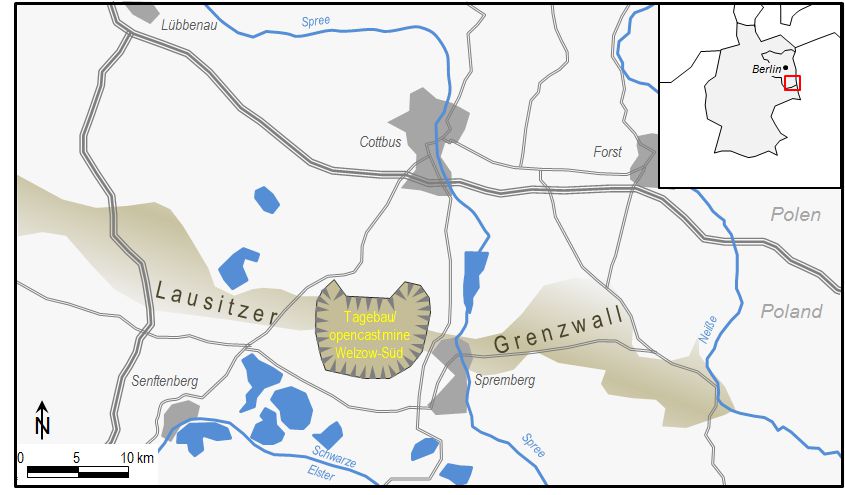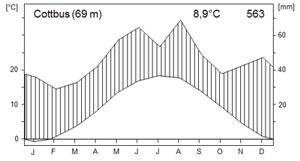Geography Chicken Creek Catchment
The Hühnerwasser ('Chicken Creek') artificial watershed is located in the lowlands of northeast Germany, in the southerastern parts of the State of Brandenburg with in the lignite opencast mine Welzow-Süd. The name of the investigation site is derived from a former small stream (the Hühnerwasser) destroyed by open-cast mining activities during the 1980s. The site falls within the region of Lower Lusatia, about 150 km southeast of Berlin close to the Polish border. Situated south of Cottbus, the area is predominantly affected by both Pleistocene glacial influences and by more modern anthropogenic disturbance including large-scale open-cast lignite mines.
The artificial watershed is located between two major glacial valleys in a landscape originally shaped by a terminal moraine deposited during the Saale stage (Warthe stadial). This hilly landscape is part of the 'Südlicher Landrücken' and the sector of this moraine south of the city of Cottbus is known as the 'Lausitzer Grenzwall'. Sandy Cambisols and Podzols of relatively low fertility are dominant in this landscape, having developed on both moraines and outwash plains. However, smaller areas of the Lausitzer Grenzwall are characterized by more loamy sediments and soils.
The climate of the region is humid with some sub-continental influence. Minimum temperatures occur in January with an average of -0.8°C; the average maximum temperature of 18.4°C is reached in July (according to 1961-1990 data from Cottbus weather station). Annual total rainfall is comparatively low at only 563 mm, with Lower Lusatia experiencing some of the lowest precipitation levels in the whole of Germany. Due to the predominantly poor sandy soils and low total annual precipitation, mixed oak-pine forests can be regarded as the potential natural vegetation of the Lower Lusatian landscape outside of the glacial valleys. The actual vegetation is currently characterized by large pine forest stands and some agricultural sites, as well as a large proportion of grasslands.
In addition to this anthropogenic alteration of the natural landscape cover, lignite mining has also influenced and disturbed large swathes of the region. Amongst a variety of influences and disturbances, open-cast mining also results in significant lowering of groundwater levels. Before the commencement of large-scale mining operations in the 1970s, several springs and small streams were present along the Lausitzer Grenzwall which fed tributaries of the river Spree. One of these was the former Hühnerwasser headwater which supplied a small stream flowing into the Spree north of Spremberg. Today this stream exists only in a few locations outside the mining area. However, the mining company Vattenfall Europe Mining AG is obliged to restore this stream after mining activities have been completed. As the complete restoration of the natural groundwater table of the landscape will take several decades, an artificial spring is needed to ensure a minimum discharge level for this stream in the near future.


